Destination Moon (film)
6.2 /10 1 Votes
60% Rotten Tomatoes Genre Adventure, Drama, Sci-Fi Duration Language English | 6.4/10 IMDb Country United States | |||||||||||||||||||||||||||||||||
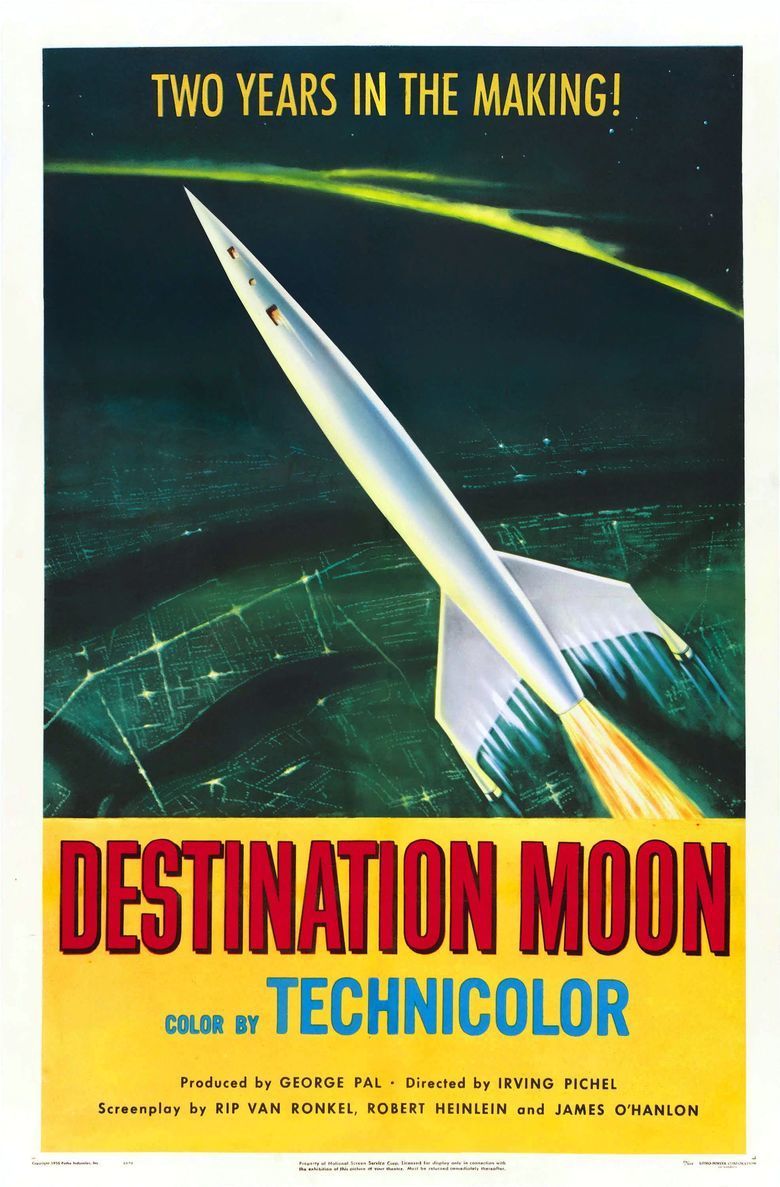 | ||||||||||||||||||||||||||||||||||
Release date June 27, 1950 (1950-06-27) (United States) Writer Alford Van Ronkel (written for the screen by), Robert A. Heinlein (written for the screen by), James OHanlon (written for the screen by), Robert A. Heinlein (from a novel by) Screenplay Robert A. Heinlein, Rip Van Ronkel, James OHanlon Cast (Jim Barnes), (Dr. Charles Cargraves), (General Thayer), (Joe Sweeney), (Emily Cargraves), Mike Miller (Man)Similar movies Interstellar , Independence Day , The Martian , Guardians of the Galaxy , Avatar , Oblivion | ||||||||||||||||||||||||||||||||||
Destination moon 1950 movie trailer
Destination Moon (a.k.a. Operation Moon) is a 1950 American Technicolor science fiction film, independently made by George Pal, directed by Irving Pichel, that stars John Archer, Warner Anderson, Tom Powers, and Dick Wesson. The film was distributed in the United States and the UK by Eagle-Lion Classics.
Contents
- Destination moon 1950 movie trailer
- Plot
- Development
- Director
- Woody Woodpecker
- Soundtrack
- Film rights
- Release
- Critical reaction
- Awards and honors
- Adaptations
- References

With Destination Moon, George Pal produced the first major U.S. science fiction film to deal with the dangers inherent in human space travel and the possible difficulties of America's first lunar mission landing on and safely returning from our only satellite.
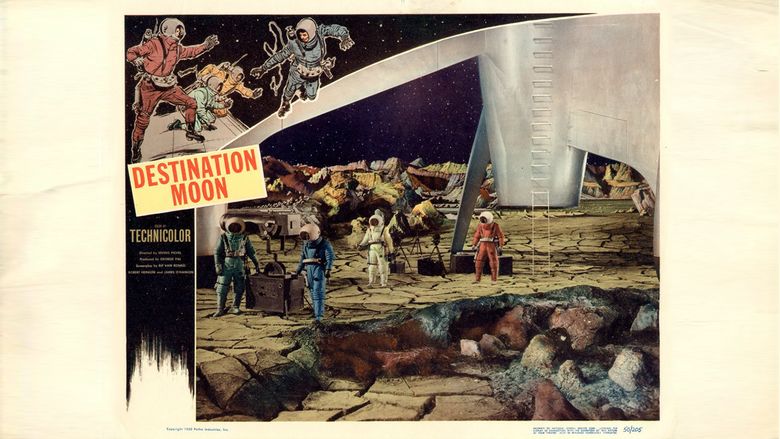
The film's premise is that U.S. private industry will mobilize, finance, and manufacture the first spacecraft to the Moon, while making the assumption that the U.S. government will then be forced to purchase or lease this new technology to remain the dominant power in space and on the Moon. Industrialists are shown cooperating to support the private venture. In the final scene, as the crew approaches the Earth, the traditional "The End" title card heralds the dawn of the coming Space Age: "This is THE END...of the Beginning".
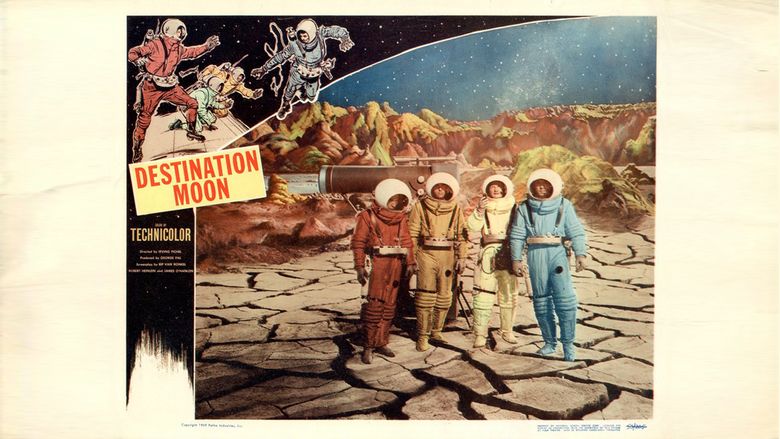
Plot
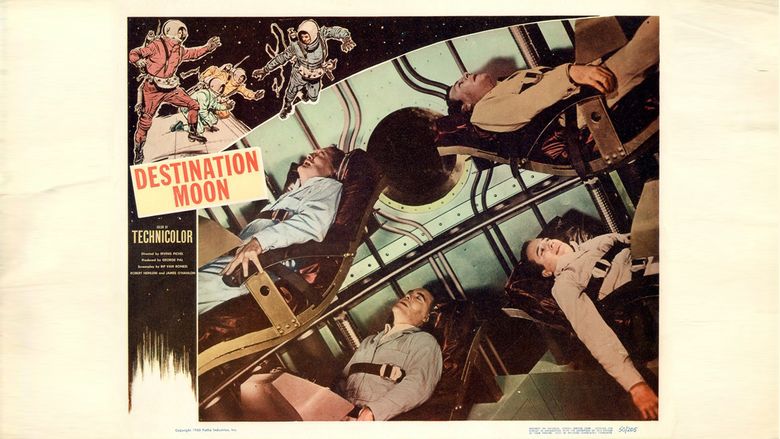
When their latest rocket test fails and government funding collapses, rocket scientist Dr. Charles Cargraves (Warner Anderson) and space enthusiast General Thayer (Tom Powers) enlist the aid of aircraft magnate Jim Barnes (John Archer). With the necessary millions raised privately from a group of patriotic U. S. industrialists, Cargraves, Warner, and Barnes build an advanced single-stage-to-orbit atomic powered spaceship, named Luna, at their desert manufacturing and launch facility; the project is soon threatened by a ginned-up public uproar over "radiation safety". The three idealists circumvent legal efforts to stop their expedition by simply launching the world's first Moon mission well ahead of schedule; as a result, they must quickly substitute Joe Sweeney (Dick Wesson) as their expedition's radar and radio operator.
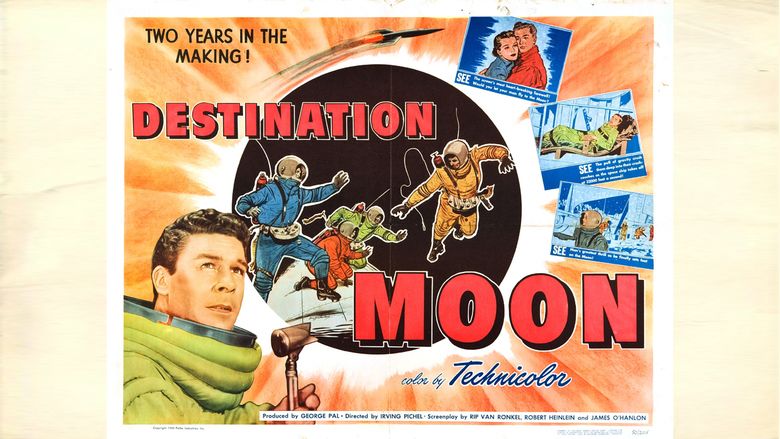
On their way to the Moon, they are forced to go outside Luna in zero gravity, wearing magnetic boots to stay on the hull to free a frozen piloting radar antenna greased-up by the inexperienced Sweeney hours before the launch. In the process they carelessly lose one of the crew overboard, untethered in free fall. He is cleverly retrieved by using the nozzle of a large oxygen cylinder as an improvised rocket motor. After achieving orbit around the Moon, the crew begins the complex landing procedure, using too much fuel during the Luna's descent phase.
Safely on the Moon, they explore the lunar surface, reporting back by radio how their view of the Earth looks contrasted against the black lunar sky; one crew member photographs another pretending to hold up the Earth like a modern Atlas. The story takes a serious turn when they calculate the mass needed to lighten their spaceship in the Moon's one-sixth gravity in order to get home safely with their remaining fuel. No matter how much non-critical equipment they remove and leave on the lunar surface, the hard numbers radioed from Earth continue to point to one conclusion: Someone will have to stay behind on the Moon if the other three crew are to return safely to Earth. With time running out for their return launch window, the crew engineers their way home. They first jettison the ship's heavy radio equipment, losing contact with Earth, and finally their sole remaining space suit. An oxygen tank is used as a tethered, suspended weight to pull the space suit outside through the open airlock, which is then remotely closed and resealed. Their critical take-off weight finally achieved, and with all her crew safely aboard, Luna blasts off from the Moon for home.
Development
Pal commissioned an initial screenplay from screenwriters James O'Hanlon and Rip Van Ronkel, but science fiction writer Robert A. Heinlein contributed significantly to Destination Moon's final screenplay, also serving as the film's technical adviser. Certain story elements from his 1947 juvenile novel Rocket Ship Galileo were adapted for use in the film's final screenplay. Heinlein also published a tie-in novella, Destination Moon, based on the screenplay. The film's storyline also resembles portions of Heinlein's novel The Man Who Sold the Moon, which he wrote in 1949 but did not publish until 1951, a year after the Pal film opened.
Destination Moon's matte paintings, used for the departure of the Luna from Earth, its approach to the Moon, the spaceship's landing on its surface, and showing the panoramic Lunar landscape, are by noted astronomical artist Chesley Bonestell.
Director
Irving Pichel was selected to direct the film, his 30th since 1932. Pichel began his Hollywood career as an actor during the 1920s and early 1930s, in such films as Dracula's Daughter and The Story of Temple Drake. Pichel had been blacklisted after he was subpoenaed by the House Un-American Activities Committee in 1947, despite having never been called to testify before HUAAC. He would go on to direct only five more films after Destination Moon before his death in 1954.
Woody Woodpecker
Cartoon character Woody Woodpecker's creator Walter Lantz and producer George Pal had been close friends ever since Pal left Europe and arrived in Hollywood. As a result, out of friendship and good luck, Pal always tried to include Woody in all his film productions. (On the commentary track of the Special Collector's DVD Edition of George Pal's 1953 science fiction film War of the Worlds, actors Ann Robinson and Gene Barry point out that Woody can be seen in a tree top, center screen, near the beginning of the film.) George Pal incorporates Woody in Destination Moon as a vital part of its unfolding storyline.
In a cartoon shown within the film, Woody explains the scientific principles behind space travel and then a trip to the Moon. This engaging cartoon is shown to a gathering of U. S. industrialists, who it is hoped will patriotically finance such a daring venture before an (unnamed) non-western power can do so successfully. The Woody cartoon actually serves the purpose of explaining, in layman's terms, to the average 1950 moviegoing audience, the practical details of a manned space expedition to the Moon and how it might be accomplished.
Soundtrack
The soundtrack music, written by composer Leith Stevens, is noteworthy for its atmospheric themes and musical motifs, all of which add subtle but important detail and emotion to the various dramatic moments in the film. According to George Pal biographer Gail Morgan Hickman, "Stevens ... consulted with numerous scientists, including Wernher von Braun, to get an idea of what space was like in order to create it musically." The Stevens Destination Moon film score had its first U.S. release in 1950 on a 10-inch 33 rpm Monaural LP by Columbia Records (#CL 6151):
Later in the 1950s, the score was re-released on a 12-inch high-fidelity mono LP by Omega Disk (#1003). Omega Disk re-released it in 1960 as a stereophonic 33 1/3 LP (#OSL-3). In 1980, the score was re-released on stereo LP by Varise Sarabande (#STV 81130) and again in 1995 on stereo LP by Citadel Records (#STC 77101). An expanded and complete 56.32 minute version of Steven's original film score, limited to 1,000 copies, was released on CD in 2012 by Monstrous Movie Music (#MMM-1967); also on the CD is Clarence Wheeler's incidental music used for the film's Woody Woodpecker cartoon. An illustrated 20-page booklet of liner notes is also included.
Film rights
Destination Moon is not in the public domain. The copyright renewal is RE-6-506 assigned to Wade Williams (the Wade Williams Collection on DVD).
Release
Despite its half-a-million dollar budget and a large national print media and radio publicity campaign preceding its delayed release, Destination Moon ultimately became the "second" space adventure film of the post-World War II era. Piggybacking on the growing publicity and expectation surrounding the Pal film, Lippert Pictures' small budget ($94,000) and quickly shot (18 days) Rocketship X-M, about the first spaceship to land on distant Mars, opened in movie theaters 25 days before the Pal feature.
Critical reaction
Bosley Crowther in his review of Destination Moon for The New York Times, opined, "... we've got to say this for Mr. Pal and his film: they make a lunar expedition a most intriguing and picturesque event. Even the solemn preparations for this unique exploratory trip, though the lesser phase of the adventure, are profoundly impressive to observe."
In a later appraisal in a Time Out review, editor John Pym saw Destination Moon as having both good and bad aspects, "... characteristically thin on plot and characterization, high on patriotism, and impressive in its colour photography and special effects; a true precursor to Star Wars."
In his autobiography Isaac Asimov called it "the first intelligent science-fiction movie made."
Awards and honors
Destination Moon won the Academy Award for Visual Effects in the name of the effects director, Lee Zavitz. The film was also nominated for the Academy Award for Best Art Direction, by Ernst Fegté and George Sawley.
At the 1st Berlin International Film Festival it won the Bronze Berlin Bear Award, for "Thrillers and Adventure Films."
Retro Hugo Awards: A special 1951 Hugo Award for Best Dramatic Presentation was retroactively awarded to Destination Moon by the 59th World Science Fiction Convention (2001) exactly 50 years later for being one of the science fiction films eligible in calendar year 1950. (50 years, 75 years, or 100 years govern the time periods when a Retro Hugo can be awarded by a Worldcon for the years prior to 1953 when the Hugos were established and first awarded.)
Adaptations
Episode 12 of the Dimension X radio series was called Destination Moon and was based on Heinlein's final draft of the film's shooting script. During the broadcast on June 24, 1950, the program was interrupted by a news bulletin announcing that North Korea had declared war on South Korea, marking the beginning of the Korean War.
Robert A. Heinlein published an adaptation in the September 1950 issue of Short Stories magazine.
A highly condensed version of the Dimension X Destination Moon radio play was adapted by Charles Palmer and was released by Capitol Records for children, who had become familiar with their recordings through a Bozo the Clown-approved record series. The series featured 7-inch, 78-rpm recordings and full-color booklets which children could follow as they listened to the stories. The Destination Moon record was narrated by Tom Reddy, and Billy May composed the incidental and background music. The record's storyline took considerable liberties with the film's plot and characters, although the general shape of the film story remained.
In 1950, Fawcett Publications released a 10-cent Destination Moon film tie-in comic book. DC Comics also published a comic book preview on the Pal film; it was the cover feature of DC's brand new science fiction anthology comic book Strange Adventures # 1 (September 1950).
The same year, Tintin Magazine released a serialization from The Adventures of Tintin stories titled Destination Moon by the Belgian cartoonist Herge. It ran from 30 March 1950 to 7 September 1950.
References
Destination Moon (film) WikipediaDestination Moon (film) IMDbDestination Moon (film) Rotten TomatoesDestination Moon (film) themoviedb.org
